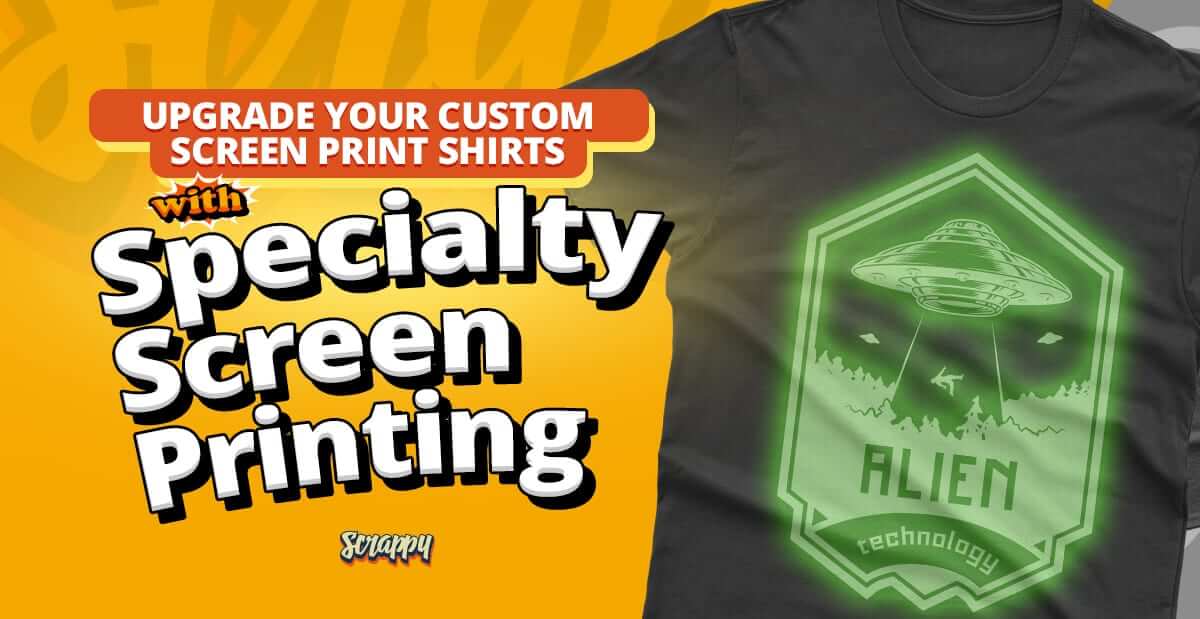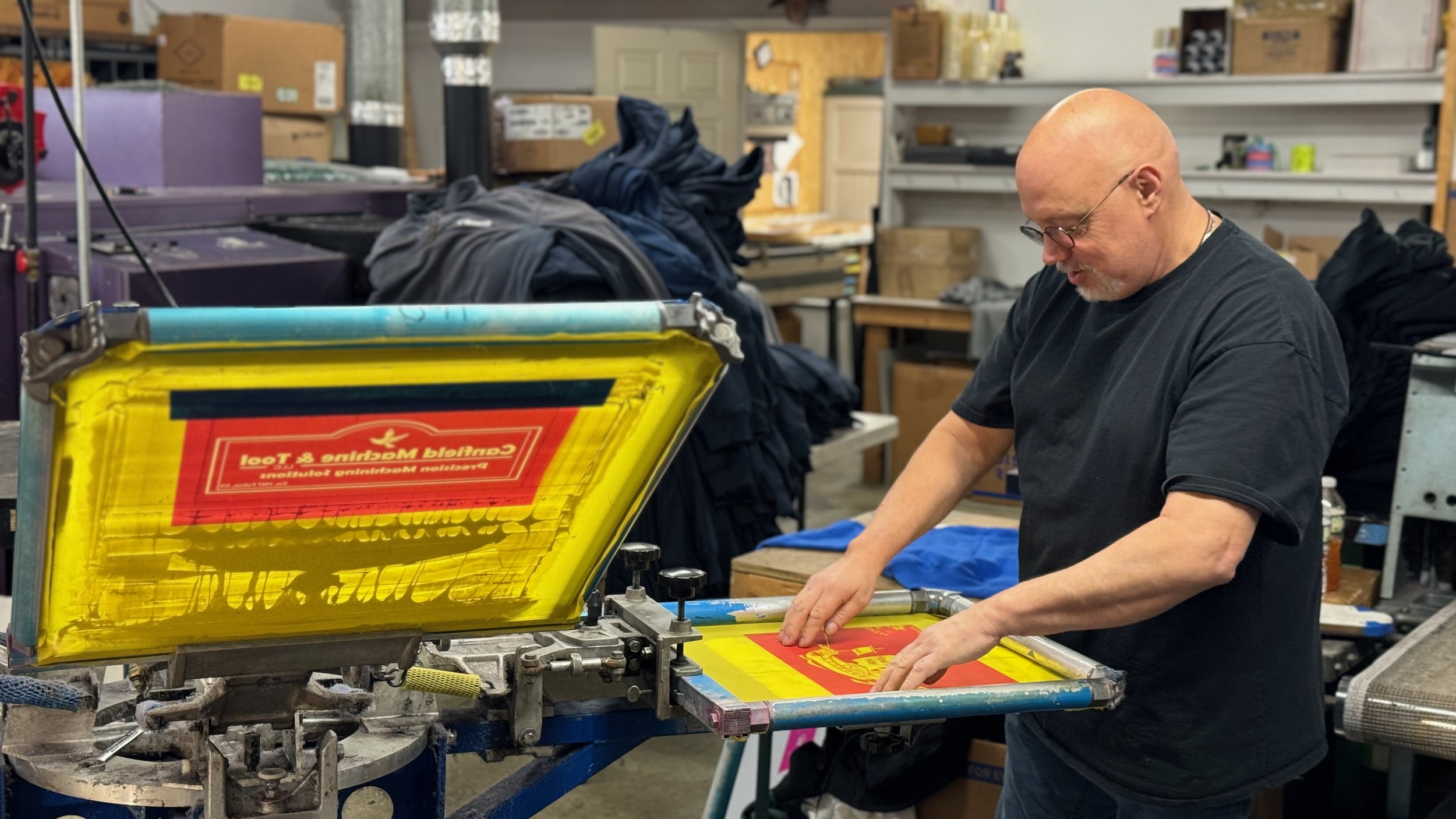High-Volume T-Shirt Printing for Schools and Organizations
High-Volume T-Shirt Printing for Schools and Organizations
Blog Article
Screen Printing Uncovered: Whatever You Required to Find Out About Tee and Garment Printing Methods
If you've ever questioned just how those dynamic designs finish up on your preferred t-shirts, you remain in the right area. Display printing is a remarkable method that incorporates art with strategy, supplying limitless possibilities for creative thinking. Understanding the fundamentals, from devices to ink selections, can substantially affect your outcomes. Ready to check out the crucial components that make display publishing an art kind? Allow's uncover the details that can elevate your projects.
The Essentials of Screen Printing: How It Works
When you plunge right into display printing, you'll find it's both an art and a scientific research. At its core, display printing includes producing a pattern, or screen, that permits ink to pass through only in certain locations (screen printing kit). You start by selecting your layout and preparing your screen with a light-sensitive solution. As soon as you subject this solution to light, it sets, leaving your style as an unfavorable space.
Following, you'll blend your inks and prepare your printing surface. Position the screen over the fabric, after that make use of a squeegee to press ink through the display onto the garment. This process calls for precision, as you want clear, vivid prints. After printing, you'll treat the ink with heat, guaranteeing it sticks to the material and lasts through washes. Each step is essential, and grasping them will certainly elevate your display printing abilities, changing simple garments right into special, meaningful pieces.
Sorts Of Screen Printing Methods
As soon as you realize the fundamentals of screen printing, it's time to check out the numerous methods that can boost your layouts. One preferred technique is traditional screen printing, where ink is pushed through a stenciled screen. This method is fantastic for vibrant, lively shades. After that there's water-based ink printing, which supplies a softer feeling and is environment-friendly, but it needs a various strategy to curing.
Another alternative is plastisol printing, understood for its longevity and dazzling shades, making it a favored for lots of brands. Experiment with halftone printing to create slope impacts and intricate styles.
Crucial Equipment for Display Printing
To attain spectacular lead to display printing, having the right devices is fundamental. You'll require a durable screen printing frame, which holds the mesh that transfers your style onto the garment. Next off, buy premium mops; these are important for applying ink equally throughout the display. You'll additionally need a good direct exposure system to create your displays, in addition to a washout cubicle for cleaning them after usage. A trusted heat source, like a conveyor dryer or warmth press, is critical for curing your prints to ensure durability. Don't fail to remember an appropriate office, equipped with tables and storage for your materials. Protective equipment, such as masks and handwear covers, will certainly maintain you risk-free from chemicals and inks. With the right devices, you'll be well on your method to producing professional-quality prints.
Selecting the Right Inks and Products
When choosing inks and materials for screen printing, you need to take into consideration the sort of ink that functions ideal for your task. Think of fabric compatibility to ensure your styles look wonderful and last lengthy. Discover eco-friendly ink alternatives to make your printing process more lasting.
Kinds Of Display Inks
Choosing the ideal display ink is vital for achieving vivid, durable prints that meet your project's needs. There are numerous sorts of display inks to analyze. Plastisol ink is preferred for its convenience and convenience of use, supplying superb color opacity on dark fabrics. Water-based ink, on the other hand, supplies a softer feeling and is eco-friendly, making it suitable for those aiming to lessen their environmental influence. Release inks remove color from the textile, causing a soft, vintage look but require particular handling. Finally, specialty inks, such as glow-in-the-dark or metallic, can add distinct results to your layouts. Evaluate your task demands and pick the ink that straightens best with your desired outcome.

Material Compatibility Factors To Consider
Comprehending fabric compatibility is crucial for accomplishing high-quality screen prints, specifically considering that various products respond uniquely to different inks. When choosing inks, consider the textile kind-- cotton, polyester, or blends. For cotton, water-based inks work well, using softness and breathability. Polyester, on the various other hand, usually calls for plastisol inks for better attachment and dynamic shades. If you're printing on blends, you may need to utilize a mix of both kinds. Constantly examine your inks on sample material to ensure they stick effectively and maintain shade honesty. Furthermore, remember that material weight and appearance can influence the last end result, so choosing the appropriate ink and product combination is important for your job's success.
Eco-Friendly Ink Options
Eco-friendly inks are becoming a prominent selection for screen printers who desire to decrease their ecological impact while preserving high quality. When choosing inks, take into consideration water-based inks, which are less damaging and much easier to clean up compared to standard solvents.
In addition, seek inks made from renewable energies, such as soy or vegetable-based options. By picking the best inks and products, you'll not only develop sensational styles but also add to a much more sustainable printing process. Make the button, and your prints will certainly mirror your dedication to the atmosphere!
Preparing Your Design for Screen Printing

File Format Requirements
To ensure your design looks Resources dynamic and sharp on textile, you'll need to pay attention to submit layout requirements for display printing. Begin with vector data like AI or EPS, as they can be scaled without losing top quality. If you use raster photos, choose high-resolution files, such as TIFF or PNG, preferably at 300 DPI. Avoid utilizing JPEGs, as they can shed quality when resized. Make sure your design has a transparent background to avoid undesirable white edges on your prints. Finally, keep color settings in mind; CMYK is common for display printing, so transform your RGB designs appropriately. By following these standards, you'll establish your artwork up for an effective print.
Shade Separation Techniques
Color separation is a vital action in preparing your style for display printing, and understanding it can considerably enhance your print quality. You'll need to damage your style right into individual shades, as each color requires a different screen during printing. Start by determining all the shades in your design and produce layers for each one. You can make use of software program like Adobe Photoshop or Illustrator to isolate and different colors efficiently. Be specific to conserve each layer as a separate file, commonly in a style like TIFF or PSD. This precision not just ensures accurate shade representation yet also improves the printing process. By paying attention to color separation, you'll attain lively and expert lead to your screen-printed garments.
Resolution and Dimension
Accomplishing the very best outcomes in display printing begins with ensuring your layout has the ideal resolution and dimension. Preferably, your artwork should be at least 300 DPI (dots per inch) for sharp, clear prints. Your final item may look amateur and pixelated. if you make use of reduced resolution.
When it involves size, think about the measurements of your print location. Layout your art work to match the last print size, ideally producing it in the real measurements you'll be publishing. In this manner, you'll stay clear of any type of unforeseen scaling problems.
Always inspect your style in both vector and raster styles. Vector graphics can be scaled without shedding top quality, making them ideal for display printing. Preparing properly will guarantee your layout looks remarkable on every garment!
Step-by-Step Display Printing Refine
Screen printing is a dynamic procedure more tips here that enables you to develop dynamic designs on various surfaces. To begin, you'll need a screen, emulsion, and your chosen ink. Prepare your screen by cleansing it thoroughly. Next off, apply the solution uniformly and allow it dry in a dark area. Once completely dry, expose your screen to light with your design positioned on it, which will solidify the emulsion where the light hits, developing a pattern - screen printing kit.
After rinsing the unexposed solution, your screen prepares. Set it up on your printing surface area and align your garment beneath it. Pour ink onto the display and make use of a squeegee to press the ink via the pattern onto the textile. Raise the display thoroughly and allow the print completely dry. Treat the ink making use of warm to assure toughness. That's it! You have actually efficiently display printed your layout.
Tips for Successful Display Printing Projects
While you're diving right into your display printing jobs, bear in mind that prep work is key to success. Beginning by gathering all your products-- inks, garments, mops, and screens. A tidy workspace aids avoid undesirable mistakes, so clean prior to you begin.
Next, verify your artwork is high-resolution and appropriately sized for your garment. Examine your screen for proper exposure and clean it extensively to stay clear of smudges. When blending your inks, adhere to the manufacturer's standards to attain the ideal consistency.
Throughout printing, apply also pressure with your squeegee for consistent results. Don't hurry; take your time to confirm each print fulfills your standards. After printing, let your garments completely dry totally prior to dealing with or packaging them.
Finally, always keep a sample of your benefit future reference. This means, you can analyze your progress and enhance your techniques gradually. Satisfied printing!

Frequently Asked Inquiries
Exactly how Lengthy Does It Take to Establish up a Display Printing Job?
Setting up a display printing job normally takes about thirty minutes to an hour. You'll prepare the screens, mix inks, and change journalism. The moment differs based on intricacy and experience, so stay organized!
Can I Print on Different Fabric Keys In Using the Exact Same Method?
Yes, you can print on different textile types utilizing the exact same method, however you'll need to readjust your settings and inks. Some textiles take in ink differently, so experimenting assurances the very best results for each product.
What Are Typical Mistakes to Avoid in Screen Printing?
When display printing, stay clear of typical blunders like making use of the wrong ink, overlooking appropriate exposure times, or avoiding pre-press checks. Constantly evaluate your configuration and maintain clean screens to guarantee high quality results each time.
Just How Can I Correctly Tidy and Maintain My Screen Printing Devices?
To appropriately tidy and preserve your display printing devices, you ought to on a regular basis wash displays with get more ideal solvents, examine squeegees for wear, and guarantee all devices are stored dust-free and dry. Uniformity prevents pricey repair work and boosts performance.
Is Screen Printing Environmentally Friendly Contrasted to Various Other Approaches?
Display printing can be a lot more eco-friendly than various other techniques, particularly if you use eco-conscious products and water-based inks. By picking sustainable products and methods, you reduce waste and minimize your influence on the planet.
Display Printing Uncovered: Everything You Need to Know Regarding T-Shirt and Garment Printing Methods
At its core, display printing includes producing a stencil, or display, that enables ink to pass with just in particular locations. Placement the display over the material, then utilize a squeegee to press ink through the screen onto the garment. One preferred technique is conventional display printing, where ink is pressed through a stenciled display.When picking inks and materials for display printing, you require to take into account the kind of ink that functions best for your project.
Report this page